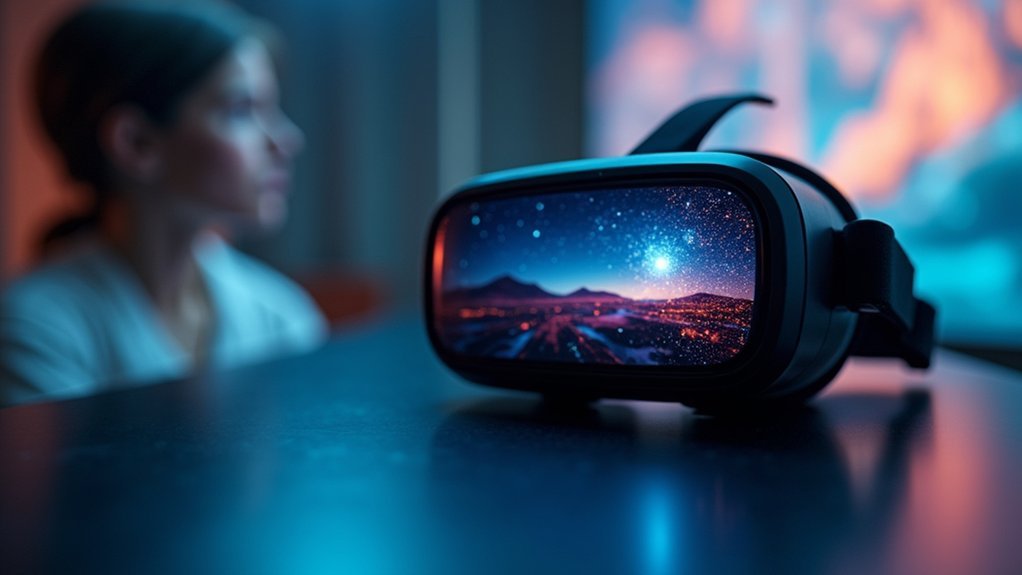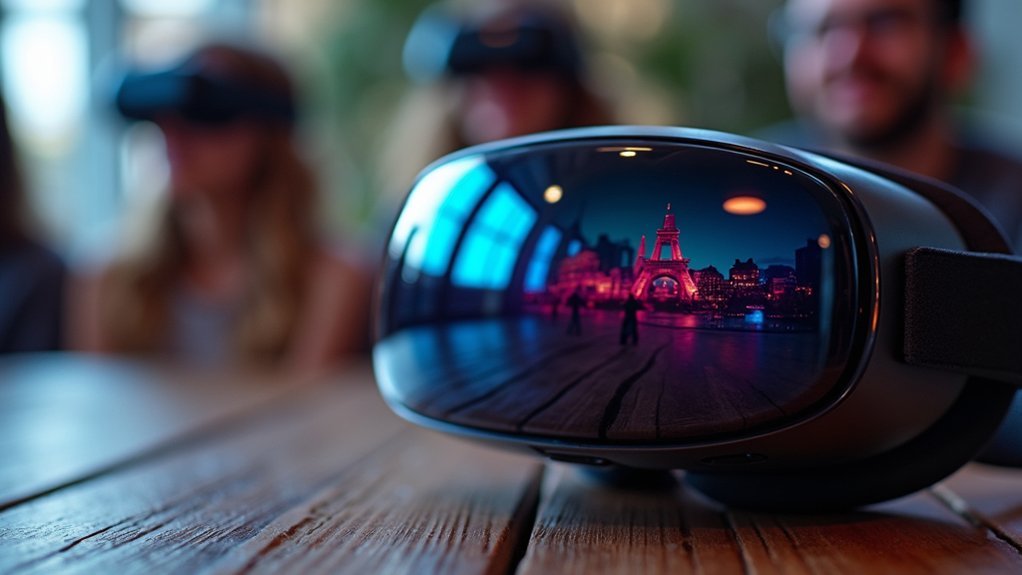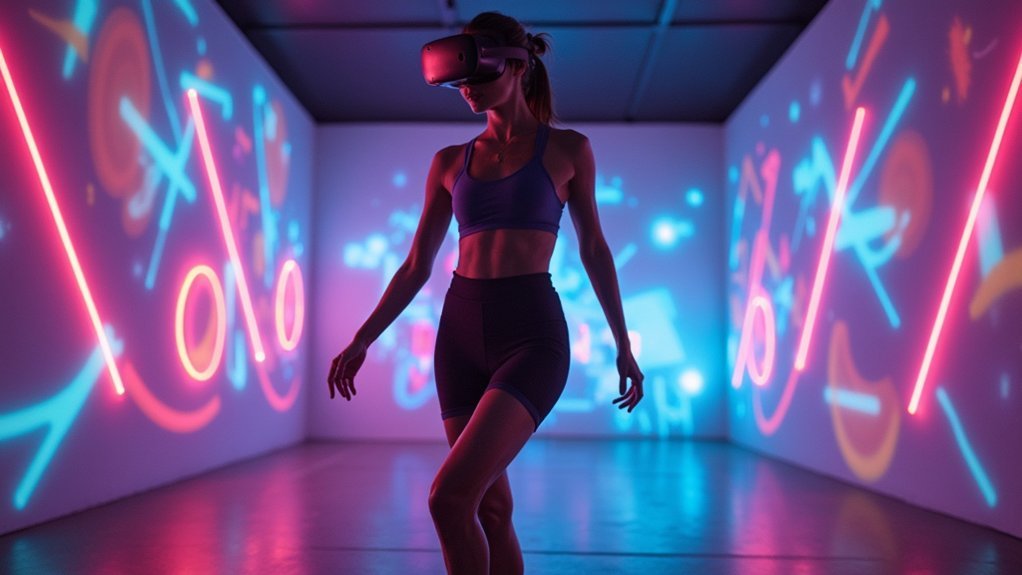Eye tracking elevates immersive headset experiences by enhancing how you interact with virtual worlds. You’ll navigate intuitively without controllers while the system renders maximum detail only where you’re looking, saving up to 50% of GPU resources. This technology reduces motion sickness, extends battery life, and enables accessibility for users with mobility limitations. Your emotional responses can be measured and content adapted in real-time, creating a more responsive and personalized experience. Discover how your gaze reveals VR’s full potential.
The Science Behind Gaze-Based Interactions in Virtual Reality
When you put on a virtual reality headset equipped with eye tracking, you’re engaging with technology that can literally read your intentions before you act. Your eye movements—fixations, saccades, and pursuit patterns—reveal whether you’re passively observing or preparing to interact with virtual objects.
High-frequency eye tracking (250 Hz) captures these subtle shifts in attention that signal your interaction readiness. The technology analyzes the complexity of your gaze through methods like Multiscale Entropy, differentiating between focused attention and exploratory scanning. This understanding transforms how VR responds to you.
Your eyes’ natural behavior creates a biological foundation for intuitive interaction, reducing reliance on controllers while creating environments that dynamically adapt to your visual attention—rendering content where you’re looking and maintaining ideal cognitive engagement. Properly calibrated systems help avoid the Midas touch problem, where unintended commands might be activated simply from looking at elements in the virtual environment.
Transforming Research With Controlled VR Eye Tracking Environments
You’ll gain unprecedented precision in eye tracking research by isolating variables in controlled VR environments that eliminate real-world distractions and confounding factors.
These immersive setups create portable research ecosystems where you can replicate exact experimental conditions across multiple sessions or locations.
The combination of environmental control and naturalistic viewing behavior transforms traditional gaze studies into more ecologically valid investigations with consistent, reproducible results. This methodology significantly enhances attentional process measurement while providing deeper insights into natural human interactions without laboratory constraints.
Precision Through Isolation
The controlled environment of VR headsets has revolutionized eye tracking research by eliminating variables that plague traditional studies. When you’re immersed in VR, you’re isolated from external distractions that typically compromise data quality.
This isolation enables unprecedented precision in your research. Headset-based eye trackers maintain calibration regardless of how you move, dramatically reducing measurement errors. You’ll find that standardized conditions can be replicated exactly across different sessions and locations, ensuring consistent results among test groups.
The minimized environmental noise translates to cleaner data, while the controlled setting allows for precise manipulation of stimuli. You can adjust variables with pixel-perfect accuracy, facilitating rigorous experimental designs that weren’t previously possible. The ability to create immersive virtual environments removes potential bias introduced by real-world settings, resulting in more authentic responses.
This combination of isolation and control creates the ideal laboratory for capturing genuine gaze behavior in three-dimensional space.
Portable Research Ecosystems
Modern VR eye tracking systems have transformed traditional research methodologies into portable, self-contained ecosystems that you can deploy virtually anywhere.
You’ll benefit from consistent experimental conditions across different locations while greatly reducing setup time and logistical costs.
These systems offer calibration-free options and real-time data processing, allowing you to gain immediate insights into participants’ behavior.
By gamifying your studies within VR environments, you’ll achieve higher engagement levels and more authentic responses.
The versatility extends beyond convenience—you can integrate eye tracking with other technologies like EEG to develop a thorough understanding of cognitive processes.
This flexibility supports collaborative projects across institutions and opens new possibilities for research that wasn’t feasible in traditional lab settings, all while maintaining high accuracy and detailed data collection.
Researchers can leverage ready-to-use templates from solutions like SightLab VR Pro to quickly build sophisticated eye tracking applications without extensive programming knowledge.
Natural Navigation: How Eye Tracking Eliminates Controller Dependency
While traditional VR systems rely heavily on handheld controllers, eye tracking technology revolutionizes how we navigate virtual worlds by responding to our natural gaze patterns.
You’ll experience more intuitive interaction as you simply look where you want to go or select objects just by focusing on them.
This controller-free approach notably enhances immersion by removing physical barriers between you and virtual environments. For users with disabilities or chronic pain, eye tracking opens new possibilities by providing an accessible alternative to manual controllers.
The technology creates more realistic experiences as virtual elements dynamically respond to your gaze. Characters might react when you make eye contact, and environments can adjust based on what captures your attention. Companies leverage this technology to analyze user behavior and preferences for improving virtual content delivery.
This natural interaction method not only simplifies your VR experience but fundamentally transforms it into something more instinctive and seamless.
Foveated Rendering: Maximizing Graphics Where Your Eyes Focus
Your eyes now control where computing power is spent, as foveated rendering directs processing resources to where you’re actively looking.
This technique saves up to 50% of GPU resources by reducing resolution in your peripheral vision while maintaining crystal-clear detail at your focal point.
The result isn’t just better performance—it’s a more realistic depth perception as the system mimics your natural visual processing, creating a seamless shift between high and low-resolution areas. The latest implementations in devices like Meta Quest Pro and Sony PlayStation VR2 showcase how eye-tracked foveated rendering has evolved into a mainstream feature for premium VR experiences.
Processing Power Savings
Foveated rendering stands as one of the most significant power-saving innovations in immersive headset technology, directly addressing the intensive GPU demands of virtual environments. By rendering only what your eyes focus on at full resolution, this technique reduces GPU workload by an impressive 30-50%.
This smart optimization translates into tangible benefits you’ll notice: extended battery life in standalone headsets, improved thermal management with less fan noise, and the ability to run more complex virtual worlds within the same hardware constraints. This technique aligns perfectly with human vision capabilities, as our eyes naturally perceive high resolution only at the center of our field of view.
The dynamic nature of modern eye-tracking systems guarantees the high-resolution zone follows your gaze in real-time, maintaining visual quality without compromising performance. Combined with Variable Rate Shading, this approach delivers the perfect balance—giving you maximum detail where it matters most while conserving valuable processing power.
Realistic Visual Depth
Beyond power savings, eye tracking enables a remarkable leap in visual realism through foveated rendering. This technology mirrors how your own eyes naturally work, delivering high-resolution detail precisely where you’re looking while reducing resolution in your peripheral vision.
When you gaze at an object in Apple Vision Pro, Meta Quest Pro, or HTC Vive Pro Eye, embedded trackers instantly detect your focus point, allocating more pixels and shading detail to that specific area. This creates convincing depth perception and 3D realism that wasn’t possible before.
You’ll experience sharper textures, more detailed shadows, and improved stereoscopic rendering exactly where your eyes need it most. This approach combats vergence-accommodation conflict and creates a more naturalistic visual experience that feels genuinely immersive rather than artificially rendered. Tests have shown this technique can reduce GPU shading load by up to 72%, allowing for more complex and realistic scenes without sacrificing performance.
Unlocking Cognitive Insights Through Visual Attention Analysis

While the human eye constantly receives vast amounts of visual information, visual attention serves as our brain’s filtering mechanism, revealing our cognitive priorities and processing methods.
Eye tracking in immersive headsets captures this cognitive window in real-time, mapping how your attention shifts between focused and distributed states.
Your eye movements directly reflect cognitive load, problem-solving approach, and mental engagement. This selective process is supported by the interaction between top-down and bottom-up attention mechanisms that determine what elements get prioritized in your visual field.
When you’re analytically solving problems, your visual attention narrows; during creative insights, it broadens.
As cognitive demands increase, you’ll experience “attentional tunneling,” reducing peripheral awareness.
Accessibility Revolution: Making VR Inclusive Through Gaze Control
The accessibility landscape of virtual reality is undergoing a transformation through eye tracking technology. You’ll find gaze control mechanisms enable unprecedented access for users with motor impairments, eliminating the need for manual input devices. This revolution creates pathways for inclusivity where traditional VR interfaces once created barriers.
- Eye tracking provides precise control over virtual environments, allowing you to manipulate objects and navigate complex spaces using only your gaze.
- For people with limited dexterity, this technology integrates with assistive systems, enhancing independence in gaming, education, and social VR experiences.
- Privacy-preserving techniques like Gaussian noise and spatial downsampling protect your sensitive gaze data while maintaining functional accuracy.
The unique patterns of eye movement in VR environments offer valuable insights that continuously improve these inclusive interfaces. Research indicates that VR users experience more limited saccades compared to natural viewing, which informs how adaptive interfaces should be designed for optimal accessibility.
Performance Optimization and Battery Conservation via Intelligent Rendering
As virtual reality headsets evolve, eye tracking emerges as a revolutionary force in rendering optimization and power efficiency. When you wear an eye-tracking enabled headset, it delivers high-resolution visuals only where you’re looking, considerably reducing GPU workload elsewhere.
This foveated rendering approach creates a cascade of benefits: your device processes fewer pixels, conserves battery power, and generates less heat—all while maintaining immersive visual quality.
You’ll experience smoother frame rates and reduced latency, essential for comfortable, extended VR sessions without motion sickness. Managing resource-intensive applications during VR usage further enhances the performance of eye tracking systems.
The freed GPU resources can enhance visual effects in your focal area or extend battery life in wireless headsets.
With eye tracking now standard in many consumer devices, you’re getting more efficient performance without sacrificing the immersive experience that makes VR compelling.
Balancing Innovation With User Privacy in Biometric Data Collection
Eye tracking’s performance benefits come with significant privacy implications that demand careful consideration. When using devices with eye tracking, you’re sharing uniquely identifiable biometric data that’s difficult to anonymize and can reveal cognitive patterns and health indicators. Devices like Vision Pro capture precise eye movement at millisecond resolution to track user engagement and interest.
The privacy landscape presents several critical challenges:
- Your gaze data, when combined with other sensor information, creates an extensive profile that could be linked across platforms without your knowledge.
- Current regulations often lag behind technological advances, creating compliance gaps for companies operating globally.
- The commercial value of eye tracking data incentivizes potential monetization, sometimes with limited user control.
As this technology advances, demanding transparency about data collection, retention periods, and explicit consent options will help preserve the benefits while protecting your digital autonomy.
The Future of Emotional Response Measurement in Immersive Experiences
Measuring emotional responses has undergone a revolutionary transformation with immersive headsets that now combine eye tracking with multiple physiological sensors.
You’ll experience up to 45% more accurate emotional assessment compared to traditional 2D methods, as these systems capture your precise gaze patterns alongside heart rate, EMG, and skin conductance data.
This technology enables real-time adaptation of content based on your emotional state. When you feel anxious or excited, the system detects these changes instantly and adjusts accordingly. REVEAL Research Centre has demonstrated how unobtrusive sensors can quantify audience feelings while maintaining the integrity of the immersive experience.
For therapists, these objective measurements reduce therapy time by up to 30% through personalized interventions. Retailers also benefit, with emotional data-driven merchandising increasing sales by 25% in documented cases.
The future promises immersive experiences that respond fluidly to your emotions, creating truly personalized interactive landscapes.
Frequently Asked Questions
How Long Does Eye Tracker Calibration Typically Take in VR Headsets?
Eye tracker calibration in VR headsets typically takes 5-30 seconds, depending on the technology used. You’ll experience shorter times with newer rapid methods or self-calibration systems that work passively during your natural usage.
Can Eye Tracking Work Effectively for Users With Vision Impairments?
Yes, eye tracking can work effectively for you if you have vision impairments. Modern systems offer customizable calibration, adaptive algorithms, and personalized parameters that accommodate your unique gaze patterns and visual limitations.
What Happens to Eye Tracking Performance in Low-Light VR Environments?
In low-light VR environments, your eye tracking remains surprisingly stable. Modern VR headsets maintain accuracy despite dim conditions, though you’ll notice some vertical linearity changes. Dynamic screen content can still create tracking challenges.
How Much Additional Battery Drain Does Eye Tracking Cause?
Eye tracking typically reduces your headset’s battery life by 15-25%. With features enabled, you’ll get about 2.5 hours instead of 3+ hours on a full charge. Disabling it when unnecessary will extend your session time.
Are Prescription Lens Inserts Compatible With Eye Tracking Systems?
Yes, prescription lens inserts are fully compatible with eye tracking systems. You’ll experience little to no degradation in tracking performance, and most inserts are designed with magnetic or clip-on features for easy installation without interfering with sensors.
In Summary
You’ve witnessed how eye tracking revolutionizes VR, from making interfaces feel magically responsive to extending battery life through smarter rendering. As you explore these immersive worlds, your gaze becomes both navigator and communicator, creating more natural, accessible experiences. While privacy considerations remain important, the technology’s ability to understand where you’re looking continues transforming how you’ll interact with virtual environments—making tomorrow’s experiences more intuitive, efficient, and emotionally connected.





Leave a Reply